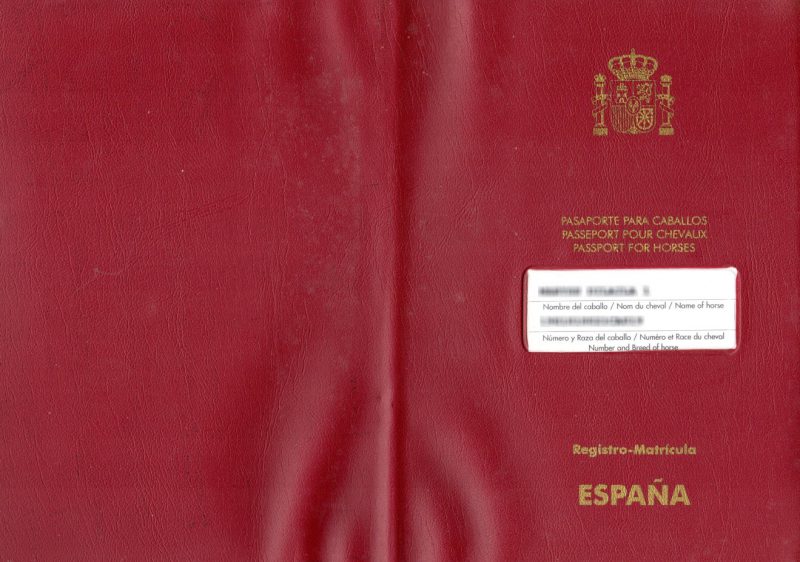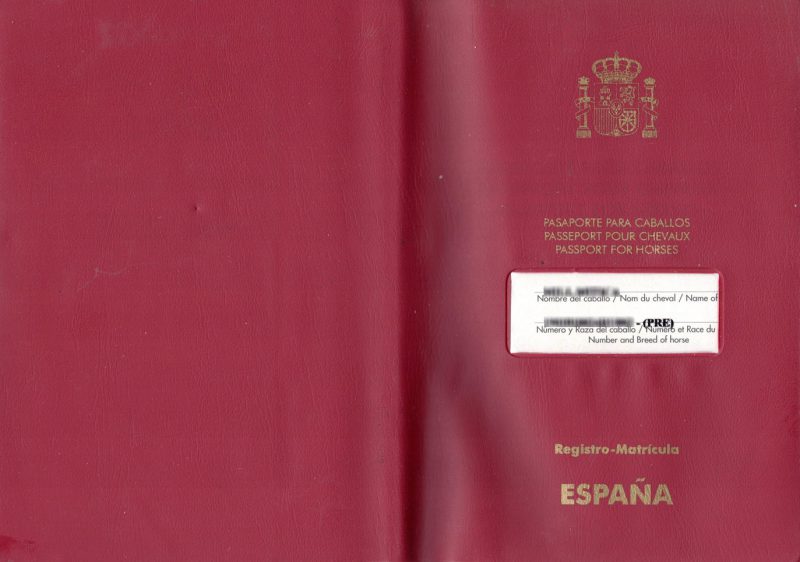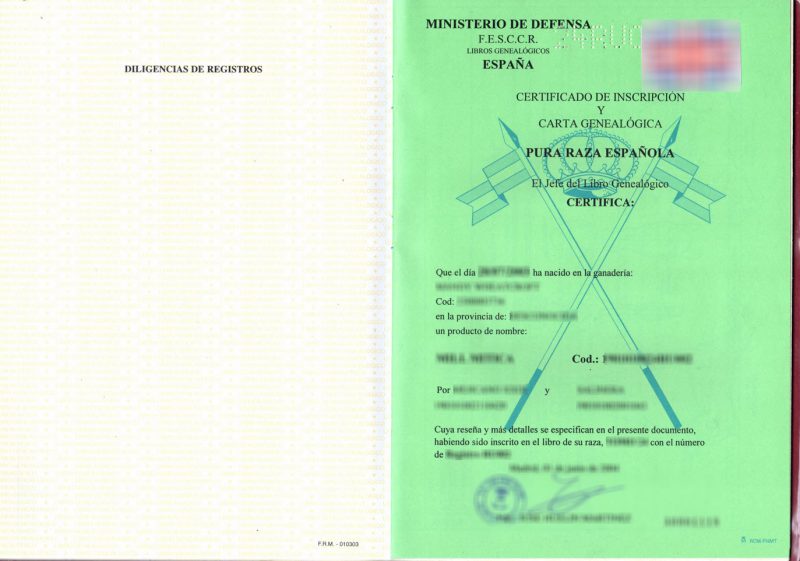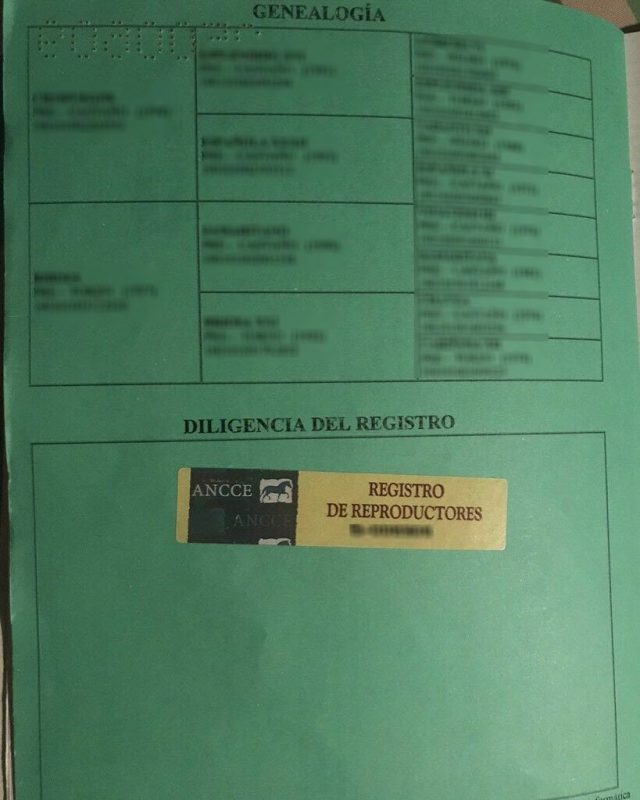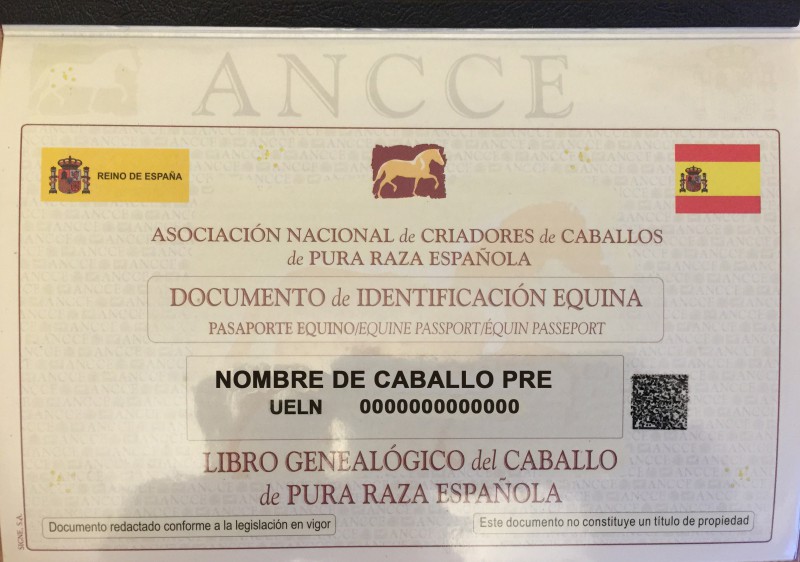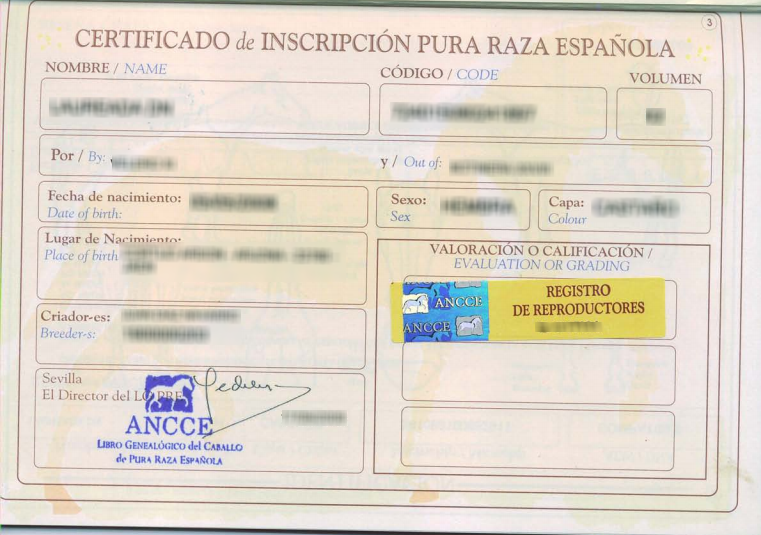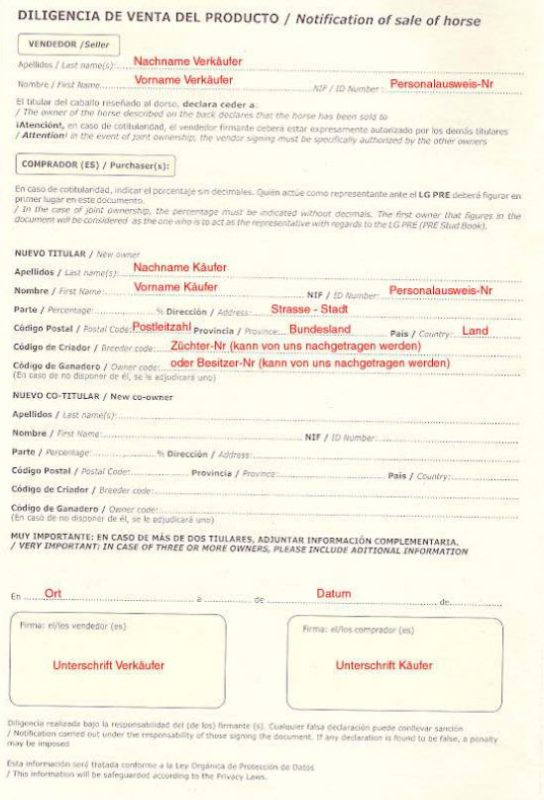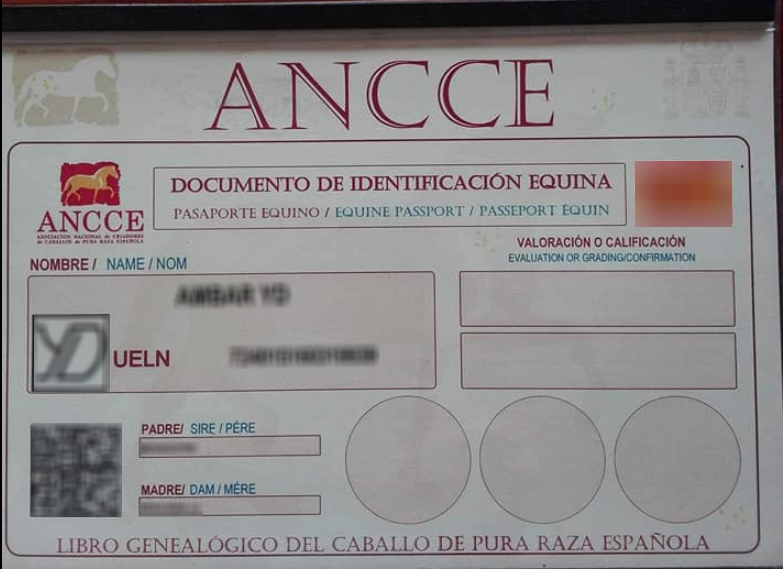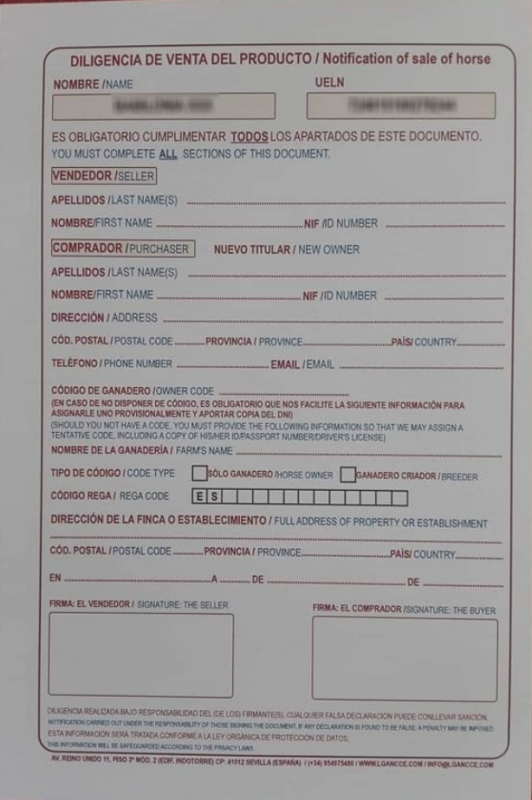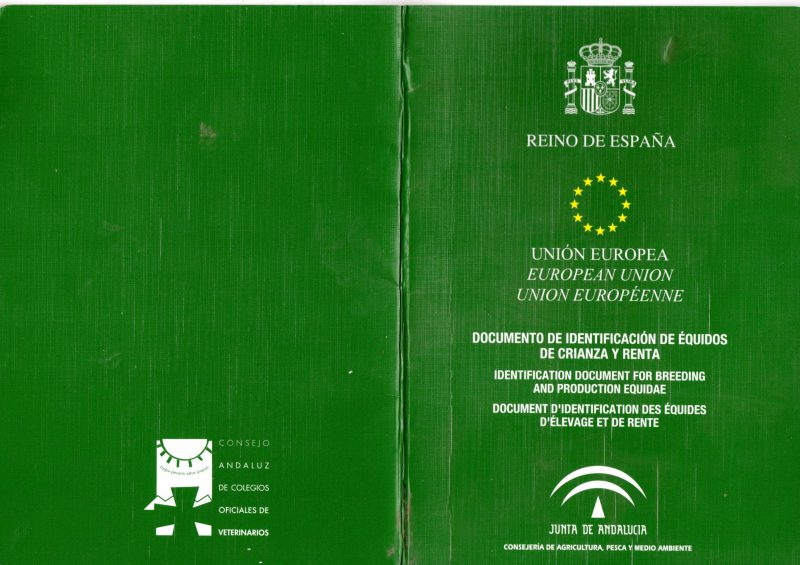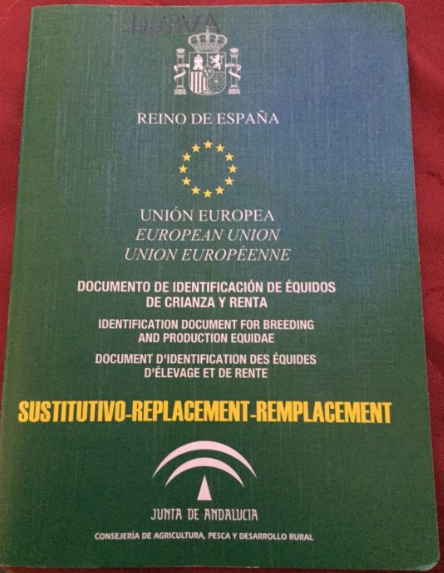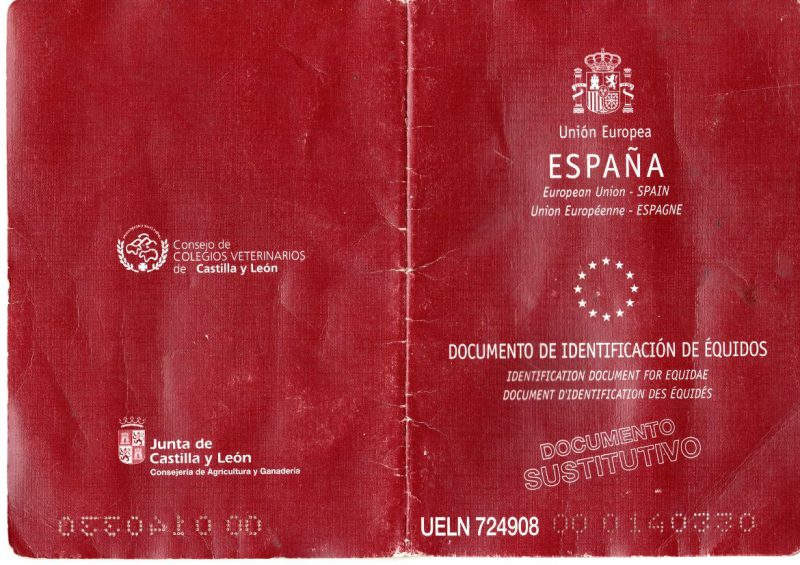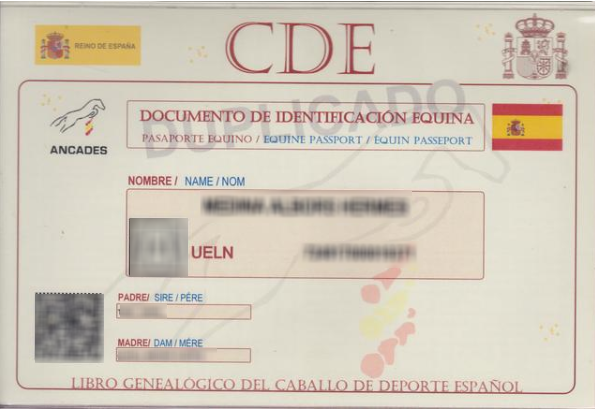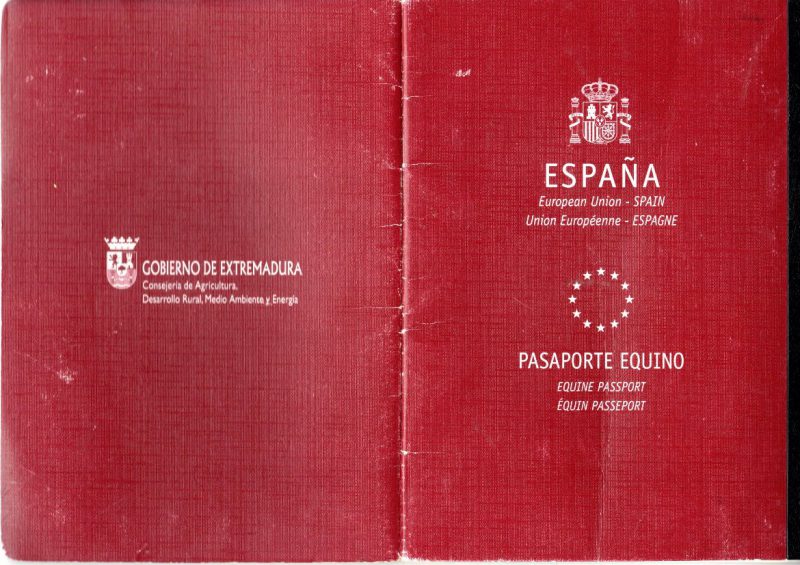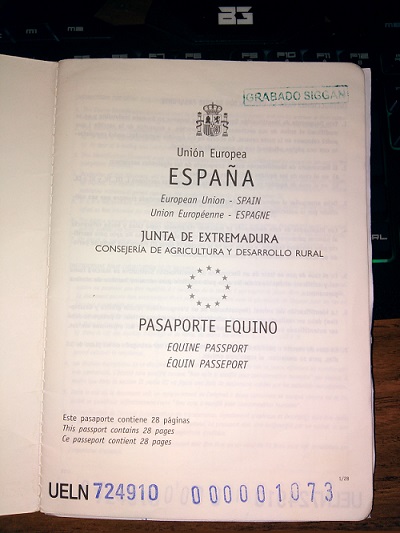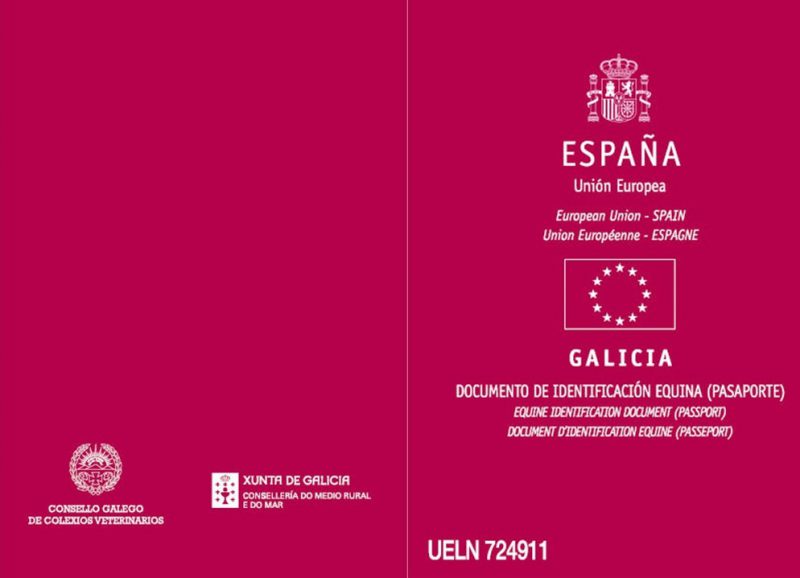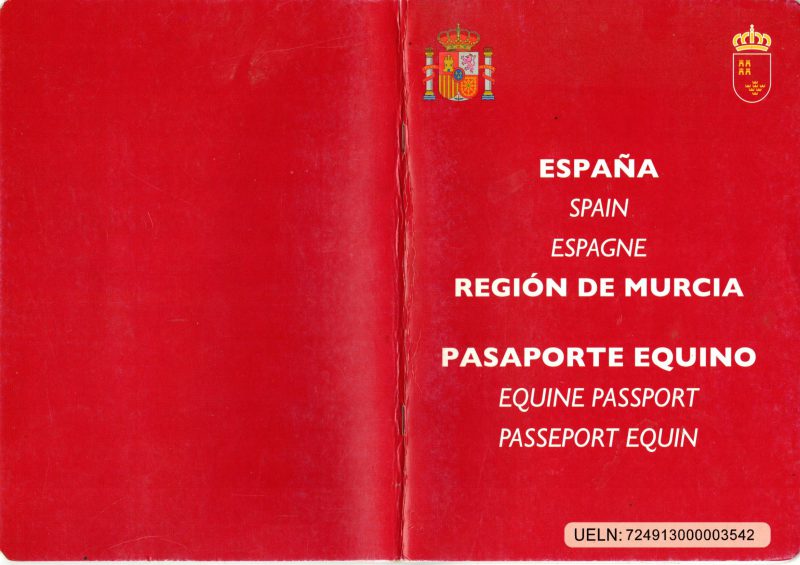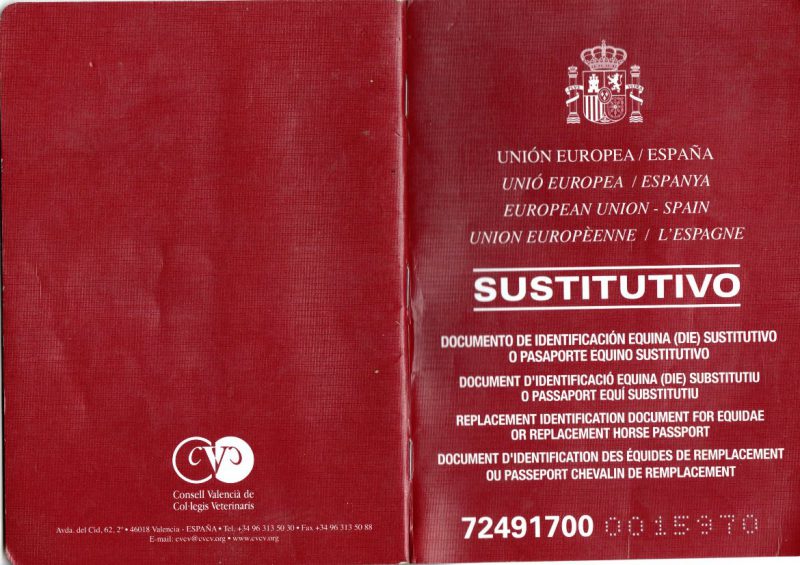ANCCE est une autorité officielle de délivrance des passeports.
Comment savoir si un passeport est un passeport d’un pure race espagnol plein papiers ?
- FESCCR Passeports 1998-2007: (Cria Caballar)
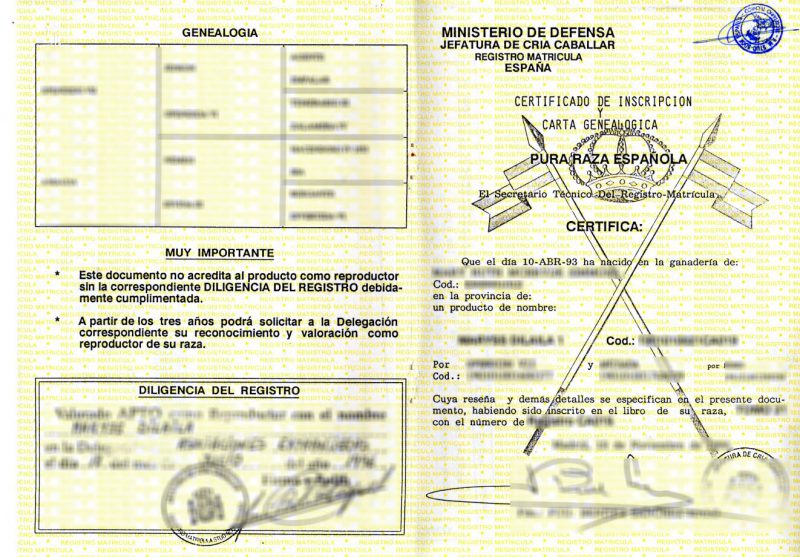
Passeport PRE: Pages extérieurs du centrefold du passeport FESCCR (1998): certificate d’origine & pedigree avec Approval For Breeding STAMP
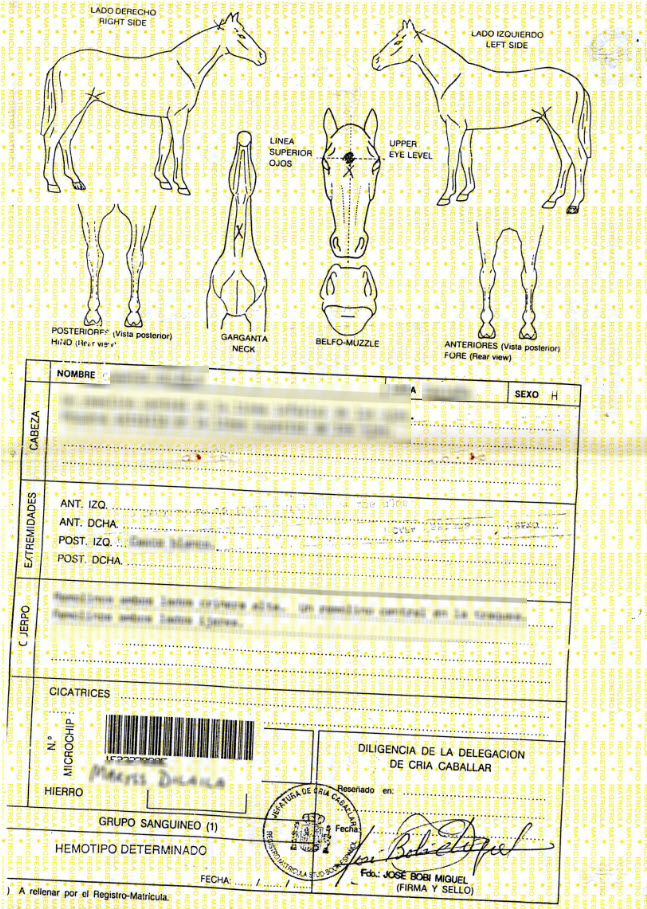
Passeport PRE: Centrefold du passeport FESCCR (1998): diagram d’identité, description, microchip & ADN
- FESCCR Passeports 1998-2007: (Cria Caballar)
Passeport PRE: Centrefold paspoort FESCCR (1998): identiteitsdiagram, beschrijving, microchip en DNA
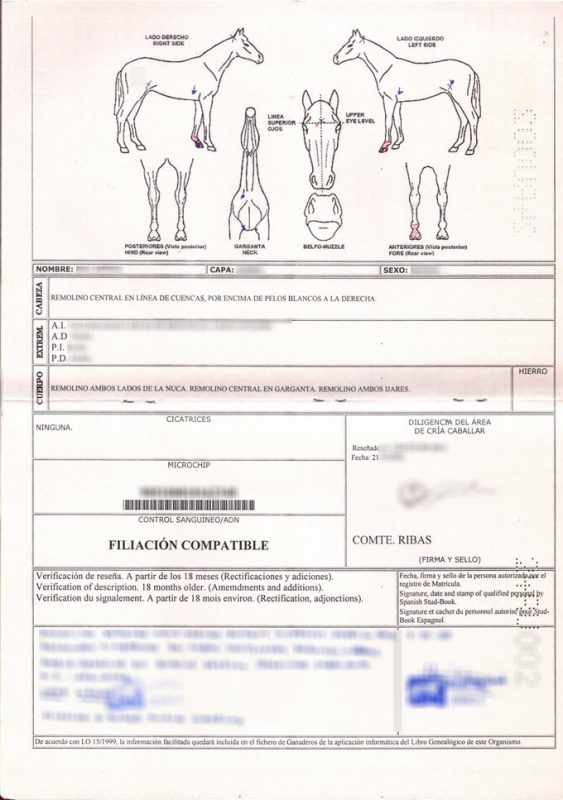
Passeport PRE: Centrefold du passeport FESCCR (2004): diagram d’identité, description, microchip et ADN
- ANCCE-LGPRE passeport et Carta de Titularidad 2007-2018:
- ANCCE-LGPRE passeport en Carta de Propriedad (2018-…):
Passeports des NON-PRE’s:
Le Cheval de sport espagnol, Caballo Deporte Español en espagnol ou abrégé CDE est un studbook de chevaux créé en Espagne en 1998. Il est constitué de chevaux de sport issus de divers croisements entre les autres races européennes. L’aptitude au saut est particulièrement recherchée.
Trouvez un cheval dans la base de données
- la base de données d’España
- la base de données de Castilla y Leon
- la base de données de CDE
- la base de données de Belgique – HorseID
Trouvez le pedigree d’un PRE
1. www.lgancce.com Cliquer sur « Consulta de Ejemplares ».


2. Taper le nom du cheval, recopier le code, puis cliquer sur « chercher ».
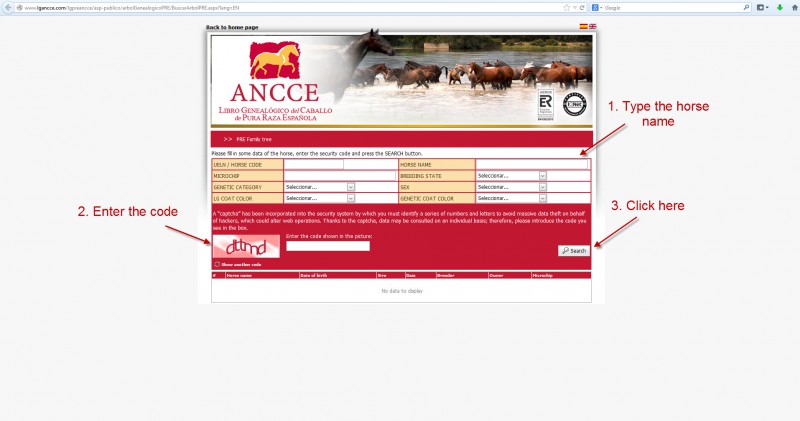
3. Cliquer sur la flèche de gauche pour voir l’arbre généalogique du cheval.
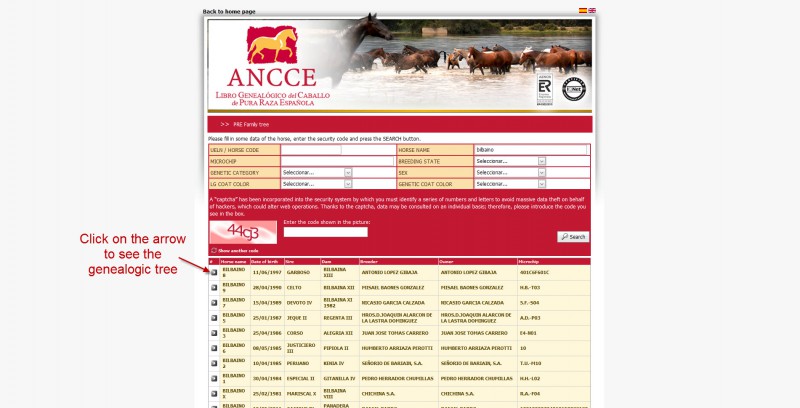
4. On peut voir le niveau de confirmation du cheval, ainsi que le nom du dernier propriétaire. Aussi, on peut dérouler les onglets pour avoir d’autres informations sur le cheval, comme son indice de morphologie, …
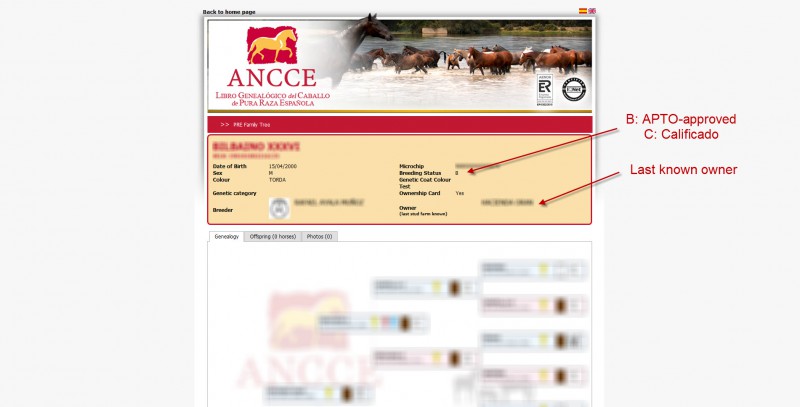
LEGENDE:
Breeding Stock Categories: plus d’info www.ancce.es
![]() Aptitud Básica para la reproducción: APTO/APTA – Certificat d’aptitude basique pour la reproduction
Aptitud Básica para la reproducción: APTO/APTA – Certificat d’aptitude basique pour la reproduction
Pour obtenir le Certificat d’aptitude basique pour la reproduction il est absolument nécessaire l’accomplissement au moins des points suivants :
- Les mâles doivent mesurer plus de 1,54m au garrot, 1,52m les femelles;
- Ne pas avoir des défauts dans le cou;
- Ne pas avoir des irrégularités dans les testicules;
- Etre fidèle au modèle racial; …
À partir de ce moment, ses descendantes seront inscrites dans le Livre Généalogique. Dans le cas contraire, l’animal conserve son certificat d’origine raciale, il continue inscrit dans le Registre de Naissances et il est considéré comme Pure Race Espagnole, mais il n’a pas le droit de registrer sa descendance.
Plus d’information de la valorisation, cliquez ici.
![]() Reproductor Calificado: Qualified Breeding Stock
Reproductor Calificado: Qualified Breeding Stock
Une évaluation supplémentaire fait dans les Tribunaux de Reproducteurs Qualifiés (TRC) c’est possible après avoir obtenu le Certificat d’aptitude basique (APTO). Cette fois sont évalués les caractères morphologiques et de conduit, le mouvement, la fonctionnalité et l’aptitude à la selle. En même temps, aura lieu un contrôle vétérinaire pour détecter possibles pathologies transmissibles et évaluer des caractères reproductifs.
Plus d’information du TRC, cliquez ici.
![]() Reproductor Jóven Recomendado: JRR – Young Recommended Breeding stock
Reproductor Jóven Recomendado: JRR – Young Recommended Breeding stock
Young Recommended Breeding Stock for Conformation:
For those horses registered in the Permanent Register of the PRE Stud Book, participants in the performance tests established in this Breeding Program, between 4 and 6 years of age and that have achieved genetic index for morphology for dressage exceeding that of 70 percent (the 30% of horses with the best genetic index). This percentage may be modified from time to time. Likewise, these horses must be outstanding, individually, for their morphologic-functional aptitudes and have exceeded the reproductive and health requirements after undergoing a radiological study to rule out diseases such as osteochondrosis and reproductive organs screened to rule out reproductive abnormalities. This category shall be applicable to horses aged 4, 5 and 6 years, on reaching the age of 7, they shall lose it.
Young Recommended Breeding Stock for Dressage:
For those horses that participate in the established performance tests (functional Dressage tests), between 4 and 6 years of age and that have achieved a genetic index for Dressage exceeding the population average. Horses must be able to demonstrate that their health and reproductive status complies with the mandates established by the Breeder Association after undergoing a radiological study to rule out diseases such as osteochondrosis and reproductive organs screened to rule out reproductive abnormalities. This category shall be available to horses aged 4, 5 and 6 years, on reaching the age of 7, they shall lose it.
![]() Reproductor Mejorante: Improver Breeding Stock
Reproductor Mejorante: Improver Breeding Stock
Improver Breeding Stock for Conformation Traits:
For breeding horses that are 7 years of age or older, that have already obtained a genetic index for conformation traits for Dressage that is above the herd average, with minimal reliability of 0.6 (repeatability) and that have sufficient descendants in the category as Young Recommended Breeding Stock, after undergoing a radiological study to rule out diseases such as osteochondrosis and reproductive organs screened to rule out reproductive abnormalities.
Improver Breeding Stock for Dressage:
For breeding horses that are 7 years of age or older, that have already obtained a genetic index for Dressage that exceeds the herd average, with minimal reliability of 0.6 (repeatability) and that have sufficient descendants in the category as Young Recommended Breeding Stock. Likewise, these horses must fulfill the conformation, reproductive and health requirements establsihed by the Breeder Association, after undergoing a radiological study to rule out diseases such as osteochondrosis and reproductive organs screened to rule out reproductive abnormalities.
![]() Reproductor de Élite: Reproducteurs d’Elite
Reproductor de Élite: Reproducteurs d’Elite
For those horses that are 7 years of age and older, which have achieved the category of Improver Breeding Stock for Morphology for Dressage and for Dressage. In addition, they must fulfill the conformation, reproductive and health requirements establsihed by the Breeder Association, after undergoing a radiological study to rule out diseases such as osteochondrosis and reproductive organs screened to rule out reproductive abnormalities.
Moreover, the genetic categories for Young Recommended Breeding Stock and Improver Breeding Stock may be obtained by all those horses assessed genetically for other equestrian disciplines (Eventing, Show Jumping, etc.):
- Horses between 4 and 6 years of age and that have obtained a genetic index for that discipline that is greter than the herd average may obtain the genetic category as Young Recommended Breeding Stock for a given discipline by participating in the performance tests established for that discipline. Horses must fulfill all reproductive and health requirements establsihed by the Breeder Association, after undergoing a radiological study to rule out diseases such as osteochondrosis and reproductive organs screened to rule out reproductive abnormalities. This category shall be available to horses aged 4, 5 and 6 years, on reaching the age of 7, they shall lose it.
- Horses that are 7 years of age or older may obtain the genetic category of Improver Breeding Stock for a given discipline upon obtaining a genetic index for that discipline that is above the herd average, with a minimal reliability of 0.6 (repeatability), and that have sufficient descendants in the category as Young Recommended Breeding Stock. Moreover, said horses must fulfill all conformation, reproductive and health requirements as established by the Breeder Association, after undergoing a radiological study to rule out diseases such as osteochondrosis and reproductive organs screened to rule out reproductive abnormalities.
Couleurs de la robe sur LG ANCCE
![]() Castaño: bai, brun
Castaño: bai, brun
![]() Alazán: alezan
Alazán: alezan
![]() Negro: noir
Negro: noir
![]() Tordo: gris
Tordo: gris
![]() Bayo: isabelle, buckskin
Bayo: isabelle, buckskin
![]() Palomino: palomino
Palomino: palomino
![]() Negro Cenizo: noir réglisse
Negro Cenizo: noir réglisse
![]() Perlino: crème/perle
Perlino: crème/perle
![]() Perla: perlino
Perla: perlino
![]() Cremello: crème
Cremello: crème
![]() Crema Cenizo: perlino
Crema Cenizo: perlino
![]() Isabelo: (double) perle
Isabelo: (double) perle
Comment savoir si mon PRE est correctement identifié en Belgique? (Confédération Belge du Cheval: CBC)
Depuis le 1er juillet 2008, tout équidé sur le territoire belge doit être identifié. Pour être en ordre d’identification, il doit:
- être accompagné d’un passeport conforme à l’Union Européenne, conforme à l’Arrêté Royal (cf. le site de la CBC);
- disposer d’un microchip (aussi appelé puce électronique ou transpondeur) placé dans l’encolure à gauche;
- être enregistré dans la banque de données belge(horseid.be).
Si vous constatez qu’un de ses trois point est manquant (p.e. parce que le cheval est importé d’un autre pays), l’équidé n’est pas en ordre. Référez-vous à la rubrique procédure pour régulariser la situation. Un cheval importé définitivement d’un autre pays doit être identifié dans un certain délai (1 à 3 mois selon le pays).
Remarque: l’inscription dans une base de données autre que la base de données officielle gérée par la Confédération Belge du Cheval n’est pas suffisante. Un équidé inscrit uniquement dans la base de données « id-chips » ou dans la base de données d’un stud-book (comme ANCCE), sera considéré comme « non identifié ».
Qu’est-ce que je risque si mon cheval n’est pas en ordre ?
Si un cheval n’est pas en ordre d’identification et de papiers lors d’un contrôle, vous risquez une amende de plusieurs centaines d’euro. Le contrôleur peut également demander une prise de sang afin de vérifier si votre cheval n’est pas porteur de l’anémie infectieuse équine. De plus, tous les chevaux présents dans l’écurie lors du contrôle pourraient être immobilisés jusqu’à avis contraire officiel. Cela signifie qu’aucun cheval ne peut quitter l’écurie car un risque sanitaire existe. Vous mettez donc les autres propriétaires dans l’embarras.

